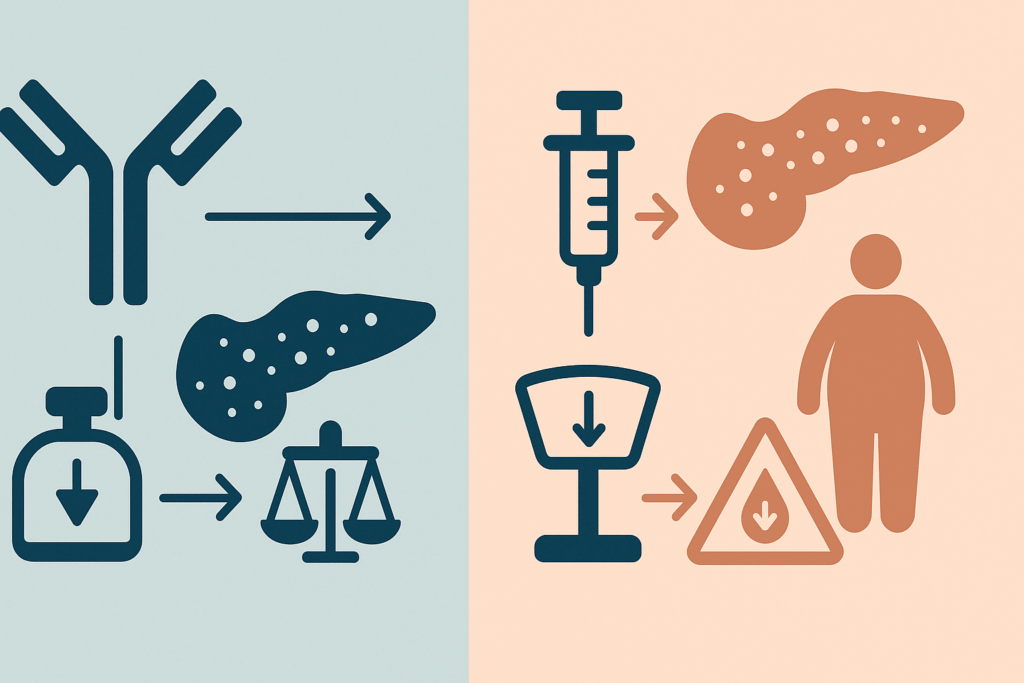Introduction: Decoding Medical Abbreviations in the Age of Precision Medicine
Medical records often serve as the silent but crucial backbone of healthcare communication. They are densely packed with shorthand, acronyms, and specialized terminology that guide clinical decisions, inform treatment strategies, and chronicle the health journeys of patients. Among the most frequently encountered yet misunderstood terms is the abbreviation “DM.” For healthcare professionals, researchers, and increasingly, patients themselves, understanding what DM stands for and how it’s applied in both clinical and research settings is essential to navigating the medical landscape with clarity. As medical literacy becomes an empowering tool for patients and providers alike, clarifying abbreviations like DM helps bridge the communication gap in the pursuit of better health outcomes.
You may also like: Breakthroughs in Current Diabetes Research: What the Latest Studies Reveal About Treatment and Prevention
The abbreviation DM most commonly refers to “diabetes mellitus,” a chronic condition that has evolved from a historical curiosity into a major global public health challenge. With the rise in electronic health records and the growing involvement of patients in managing their own care, terms like DM appear regularly in lab results, doctor’s notes, and diagnostic summaries. This article provides a comprehensive exploration of the diabetes medical abbreviation, how it is used in medical records and research, and why its proper interpretation matters deeply in today’s healthcare systems.

Understanding the Core Meaning of DM in Medical Records
At its most fundamental level, DM in medical records stands for “diabetes mellitus,” a group of metabolic disorders characterized primarily by high blood glucose levels over a prolonged period. Derived from Latin and Greek origins—”diabetes” meaning “to siphon” and “mellitus” meaning “honey-sweet”—the term dates back to ancient medicine when physicians noted the sweet taste of diabetic urine. While the etymology may sound antiquated, the implications of this diagnosis in modern healthcare are vast and serious.
Diabetes mellitus is typically classified into three main categories: type 1 diabetes, type 2 diabetes, and gestational diabetes. When a physician writes DM in a medical record, it is usually accompanied by further qualifiers such as “DM type 1” or “DM type 2” to specify the exact form. However, in some cases, particularly when space is limited or the context is general, only the abbreviation DM is used. This is why a thorough understanding of the patient’s history, age, and other medical indicators is vital when interpreting the abbreviation.
The presence of DM in a medical record may indicate a current diagnosis, a past condition under control, or a risk factor for other diseases. For instance, a patient undergoing cardiovascular surgery may have “hx of DM” noted in their chart, meaning a history of diabetes mellitus. This notation significantly affects preoperative planning, postoperative management, and long-term care strategies. Thus, the meaning of DM is not just semantic—it has concrete implications for clinical decisions and outcomes.
Why Proper Interpretation of the Diabetes Medical Abbreviation Matters
The stakes involved in misinterpreting medical abbreviations can be high. In the case of DM, failing to recognize that it refers to diabetes mellitus could lead to overlooked blood sugar monitoring, missed diagnoses, or improper medication administration. For example, a patient with DM requires specific considerations during pharmacologic treatment, wound healing, and dietary planning. If the abbreviation is misread or misunderstood, the chain of care coordination may be compromised.
Moreover, understanding the diabetes medical abbreviation is also key to decoding comorbidities and complications listed in patient files. For instance, a notation such as “DM with neuropathy” suggests the patient has progressed to a stage of diabetes where nerve damage is present—a signal for more intensive management and surveillance. In research settings, the consistent and accurate use of “DM” in medical data is vital for study designs, epidemiological surveys, and clinical trials.
Patients are also increasingly interacting with their digital health records. As they encounter abbreviations like DM, a lack of clarity can foster confusion, anxiety, or misinterpretation. A person reading their chart may not immediately know that DM refers to diabetes mellitus and may misattribute symptoms or misunderstand the nature of their condition. Thus, medical professionals should aim to improve transparency and support patient education around medical shorthand.

DM in Clinical Documentation: From SOAP Notes to EHRs
Medical professionals often employ structured frameworks like SOAP (Subjective, Objective, Assessment, Plan) notes to document patient encounters. Within these frameworks, DM is commonly listed in the assessment or problem list to denote a known or suspected case of diabetes mellitus. For instance, a primary care provider might write: “Assessment: DM type 2, uncontrolled,” to indicate a patient’s condition and suggest that tighter glucose control is needed.
The use of DM has evolved with the digitalization of healthcare records. In electronic health records (EHRs), standardized templates may auto-populate terms like DM based on diagnostic codes (e.g., ICD-10 codes such as E11.9 for Type 2 diabetes without complications). While this ensures consistency, it also raises concerns about over-reliance on abbreviations without context. For clinicians, it’s essential to ensure that the use of DM in such systems is always accompanied by descriptive notes and not left in isolation.
There are also variations in how DM is recorded depending on the specialty. In endocrinology, the abbreviation may be accompanied by more detailed metrics such as HbA1c levels, fasting glucose values, or insulin regimens. In cardiology, DM may be linked to assessments of cardiovascular risk. Understanding these nuances in clinical documentation is essential for ensuring comprehensive care and accurate medical communication.

Research Perspectives: How the DM Check Medical Abbreviation Supports Epidemiological Studies
In medical research, abbreviations like DM play an essential role in enabling large-scale data analysis and cross-referencing among population groups. Researchers conducting epidemiological studies often rely on electronic databases and health registries where the abbreviation “DM” is used as a standardized code for identifying diabetic patients. This allows for efficient stratification of study cohorts, analysis of risk factors, and assessment of outcomes.
When performing a “DM check medical abbreviation” in clinical databases, researchers are essentially verifying which subjects carry a documented diagnosis of diabetes mellitus. This process is crucial for ensuring data integrity and avoiding misclassification bias. It becomes especially important in retrospective cohort studies, where records are reviewed to identify the presence or absence of specific conditions.
Additionally, consistent use of the diabetes medical abbreviation in medical literature and datasets facilitates meta-analyses and systematic reviews. It allows for interoperability between studies, ensuring that findings about diabetes prevalence, treatment efficacy, or complication rates can be compared across different populations and settings. However, reliance on abbreviations also requires vigilance; researchers must ensure that the DM abbreviation is not confused with other potential meanings, such as “dermatomyositis” or “disease management,” depending on context.
Emerging artificial intelligence (AI) applications in medicine are also leveraging natural language processing (NLP) to scan medical texts for terms like DM. In these contexts, accurate labeling and consistent abbreviation usage directly impact the performance of predictive models, diagnostic algorithms, and risk stratification tools. As such, a well-executed DM check medical abbreviation process enhances not just traditional research, but the future of intelligent, data-driven healthcare systems.

Patient Empowerment and the Rise of Health Literacy
As patients increasingly gain access to their own medical records through digital portals, understanding medical abbreviations becomes a key component of health literacy. The abbreviation DM may appear in lab reports, physician notes, or even after-visit summaries without further explanation. For someone unfamiliar with medical jargon, this could lead to misinterpretation or concern, especially if they do not know that DM refers to diabetes mellitus.
Educational initiatives aimed at improving patient health literacy should prioritize commonly used abbreviations like DM. This is especially relevant given the rising global prevalence of diabetes, particularly type 2 diabetes, and the importance of early intervention. When patients understand the terms used in their health records, they are better equipped to engage in informed decision-making, adhere to treatment plans, and communicate effectively with healthcare providers.
Technology platforms that offer “hover-over” definitions or clickable explanations of terms like DM could help bridge the understanding gap. Healthcare systems and providers should also consider simplifying communication without compromising accuracy. For example, writing “Diabetes Mellitus (DM)” the first time the term is mentioned in a patient document can set the stage for clarity while maintaining clinical precision.
A more informed patient is an empowered patient. By demystifying the diabetes medical abbreviation and related terminology, healthcare providers foster a collaborative environment that supports better long-term outcomes, especially for chronic diseases like diabetes that require sustained lifestyle and pharmacologic management.

Common Misunderstandings and the Importance of Context in Interpreting DM
One of the critical challenges in using medical abbreviations is that the same acronym may refer to multiple conditions, depending on the medical specialty or regional conventions. While DM almost universally refers to diabetes mellitus in general practice, it can also stand for “dermatomyositis,” a rare inflammatory disease affecting the skin and muscles, or “disease management” in a broader healthcare operations context. In some psychiatric or neurological records, it might be shorthand for “decision-making” or even “dementia,” though these uses are relatively rare.
Context is key when interpreting the meaning of DM in any clinical or research setting. The surrounding information in a patient’s medical history, including age, medications, symptoms, and lab values, usually clarifies whether DM refers to diabetes mellitus or something else. For instance, a chart that includes medications like metformin or insulin, or test results showing elevated blood glucose, makes it overwhelmingly likely that DM refers to diabetes.
This is where standardized documentation practices and clinician training become vital. Ambiguity in medical records can lead to clinical errors, especially when patient care is transferred between providers or institutions. EHR systems should allow for disambiguation of abbreviations by encouraging expanded forms alongside acronyms. For researchers conducting a dm check medical abbreviation process, attention to such nuances is necessary to ensure accuracy and avoid the inclusion of irrelevant data points.
Clinicians should also be aware of how cultural and regional variations in medical terminology may impact interpretation. For example, British and American English sometimes differ in medical shorthand usage, which may influence the way DM and other abbreviations are recorded and interpreted across international collaborations.

Frequently Asked Questions (FAQ): Understanding DM in Medical Records and Emerging Diabetes Treatments
1. How does a DM check medical abbreviation process enhance clinical accuracy in hospital settings?
A DM check medical abbreviation process refers to systematically reviewing patient records to verify that the term “DM” correctly represents a diagnosis of diabetes mellitus. In hospital settings, this check helps avoid diagnostic ambiguity, especially in complex cases with multiple comorbidities. Given that DM can occasionally refer to other conditions like dermatomyositis or disease management, confirming its intended meaning reduces the risk of treatment errors. This kind of verification becomes especially crucial when integrating data from multidisciplinary teams or transferring records between facilities. Additionally, using technology-assisted checks—like natural language processing algorithms—can automatically flag contextually inconsistent uses of the diabetes medical abbreviation, strengthening the reliability of clinical documentation.
2. What are the broader implications of DM abbreviation misinterpretation in public health data?
Public health research often relies on large-scale databases where a misinterpretation of the DM abbreviation can skew prevalence data, risk modeling, and outcome tracking. When a dm check medical abbreviation protocol isn’t rigorously applied, there’s a risk of including non-diabetic patients in diabetes cohorts or excluding valid cases. This impacts the allocation of healthcare resources and the accuracy of epidemiological forecasting models. For instance, regional diabetes rates might be underreported if the abbreviation is inconsistently used or misclassified. To combat this, public health data scientists are now integrating machine learning tools to validate instances of the diabetes medical abbreviation against corroborating clinical indicators such as blood glucose levels or medication history.
3. Does tirzepatide lower blood sugar differently than traditional therapies like metformin?
Yes, tirzepatide lowers blood sugar through a unique dual mechanism that distinguishes it from older agents like metformin. While metformin primarily reduces hepatic glucose production, tirzepatide mimics both GIP (glucose-dependent insulinotropic polypeptide) and GLP-1 (glucagon-like peptide-1), hormones that stimulate insulin secretion in response to meals. This dual receptor agonism enhances glucose-dependent insulin release, suppresses glucagon, and delays gastric emptying, all of which contribute to improved glycemic control. Clinical trials show that tirzepatide for diabetes often results in greater A1C reductions than traditional monotherapies. Moreover, its effectiveness across a range of baseline A1C levels has sparked interest in its use for broader metabolic disorders beyond type 2 diabetes.
4. How does tirzepatide compare with insulin therapy for long-term diabetes management?
Although both aim to control blood sugar, tirzepatide and insulin differ fundamentally in administration, mechanism, and risk profiles. Tirzepatide for diabetes not only improves glycemic control but also promotes weight loss, making it a more favorable option for patients with obesity-linked type 2 diabetes. In contrast, insulin therapy often leads to weight gain and requires more rigorous monitoring to avoid hypoglycemia. Notably, tirzepatide is not insulin but can sometimes be used adjunctively with basal insulin when additional glycemic control is needed. Clinical trials suggest that patients may achieve better metabolic profiles with fewer hypoglycemic events when tirzepatide is introduced before escalating insulin doses. However, careful consideration is needed in advanced cases of insulin resistance where combination therapy may still be warranted.
5. Can tirzepatide cause low blood sugar, and what are the warning signs?
Yes, tirzepatide can cause low blood sugar, but this typically occurs when it is used in combination with other glucose-lowering medications such as sulfonylureas or insulin. On its own, the risk is relatively low because its insulin-stimulating effects are glucose-dependent. Still, individuals should be educated about the signs of hypoglycemia—shakiness, dizziness, sweating, confusion, or irritability—and monitor their glucose regularly when starting tirzepatide. When hypoglycemia does occur, it’s often mild and resolves with carbohydrate intake. Patients should also be aware that the risk of tirzepatide low blood sugar increases in cases of inconsistent meal timing or excessive physical exertion without nutritional compensation.
6. What role does tirzepatide play in the management of prediabetes, and is Mounjaro a viable option?
There is growing interest in using tirzepatide for prediabetes, particularly in individuals with obesity and insulin resistance. Mounjaro, the brand name for tirzepatide, is being investigated for its capacity to reverse metabolic dysfunction before the onset of full-blown diabetes. Preliminary studies suggest that individuals with prediabetes Mounjaro regimens can experience significant improvements in glucose tolerance, insulin sensitivity, and weight. These metabolic shifts could potentially delay or even prevent the progression to type 2 diabetes. However, because tirzepatide is currently FDA-approved only for type 2 diabetes, off-label use for prediabetes should be approached with caution and under expert medical supervision.
7. Why is it important for patients to understand the context of the diabetes medical abbreviation in their health records?
Understanding the diabetes medical abbreviation helps patients make sense of their health status and fosters more productive conversations with healthcare providers. For instance, a patient reading “DM with nephropathy” in their chart may not realize this refers to kidney complications related to diabetes unless explained clearly. Misinterpreting this could lead to unnecessary anxiety or misinformed health decisions. Enhanced patient education initiatives—such as providing pop-up definitions in patient portals or integrating medical glossaries—can help demystify such terms. A thoughtful dm check medical abbreviation approach that includes patient-friendly annotations supports shared decision-making and builds medical trust.
8. What innovations are emerging in digital health tools to streamline the dm check medical abbreviation process?
Artificial intelligence is increasingly being deployed to perform automated dm check medical abbreviation validation in EHRs and research datasets. These systems use contextual language models to differentiate between similar abbreviations based on surrounding data such as medications, diagnoses, and lab values. Some hospital systems are now integrating AI-driven alerts that flag potentially ambiguous uses of DM, prompting healthcare providers to review or clarify entries. This improves not only the accuracy of the diabetes medical abbreviation in records but also enhances coding integrity for insurance and reimbursement processes. As these technologies mature, their role in standardizing medical language will be essential for global interoperability of health data.
9. Are there any lifestyle changes patients should prioritize when starting tirzepatide for diabetes or prediabetes?
Absolutely—tirzepatide should be seen as a powerful tool but not a substitute for lifestyle modification. Patients initiating tirzepatide for diabetes or prediabetes Mounjaro therapies are encouraged to follow a balanced diet rich in fiber, lean proteins, and healthy fats. Physical activity remains vital, as it amplifies insulin sensitivity and supports the weight-reducing effects of the medication. Moreover, regular sleep patterns and stress management can optimize metabolic outcomes. Patients should also be vigilant for early signs of tirzepatide low blood sugar, particularly when modifying caloric intake or adding other glucose-lowering agents.
10. How might future updates to electronic health record systems improve clarity around the diabetes medical abbreviation?
Upcoming EHR enhancements are likely to prioritize contextual clarity for common abbreviations like DM. For example, new systems may automatically expand the first instance of “DM” to “diabetes mellitus” in patient summaries or include dynamic hover-text definitions. Innovations like real-time dm check medical abbreviation validation could alert clinicians if a note includes conflicting information—such as a DM diagnosis without supporting glucose data. These changes will be particularly useful in interdisciplinary settings where non-endocrinology professionals interact with the record. Ultimately, consistent and intelligible use of the diabetes medical abbreviation will support more effective care coordination, minimize errors, and empower patients to engage confidently with their health data.
Conclusion: The Critical Role of Clarity in Using the Diabetes Medical Abbreviation
In a healthcare environment increasingly defined by complexity, data integration, and patient engagement, the meaning behind abbreviations like DM carries more weight than ever. Whether in a clinical chart, a digital health portal, or a large-scale research database, the proper use and interpretation of DM as a diabetes medical abbreviation is essential for ensuring effective communication, appropriate care, and accurate scientific conclusions. As we strive toward a more transparent and patient-centered healthcare system, it is crucial to prioritize clarity and context in how medical information is recorded and conveyed.
Understanding what DM means in medical records isn’t just a matter of semantics—it is a cornerstone of safe, informed, and compassionate care. For healthcare professionals, accurate documentation ensures proper clinical management and data integrity. For researchers, it supports the validity and reproducibility of scientific studies. And for patients, deciphering abbreviations like DM empowers them to take ownership of their health, fostering stronger partnerships with their care teams.
Ultimately, the goal of any healthcare system should be to promote shared understanding. In this context, something as seemingly small as clarifying the term DM can ripple outward, shaping better experiences, improved outcomes, and more humane medicine. In a world where chronic diseases like diabetes continue to rise, such clarity isn’t optional—it’s essential.
Was this article helpful? Don’t let it stop with you. Share it right now with someone who needs to see it—whether it’s a friend, a colleague, or your whole network. And if staying ahead on this topic matters to you, subscribe to this publication for the most up-to-date information. You’ll get the latest insights delivered straight to you—no searching, no missing out.
Further Reading:
What does dm stand for in medical terms
Standards of Medical Care in Diabetes—2014
Disclaimer
The information contained in this article is provided for general informational purposes only and is not intended to serve as medical, legal, or professional advice. While MedNewsPedia strives to present accurate, up-to-date, and reliable content, no warranty or guarantee, expressed or implied, is made regarding the completeness, accuracy, or adequacy of the information provided. Readers are strongly advised to seek the guidance of a qualified healthcare provider or other relevant professionals before acting on any information contained in this article. MedNewsPedia, its authors, editors, and contributors expressly disclaim any liability for any damages, losses, or consequences arising directly or indirectly from the use, interpretation, or reliance on any information presented herein. The views and opinions expressed in this article are those of the author(s) and do not necessarily reflect the official policies or positions of MedNewsPedia.


